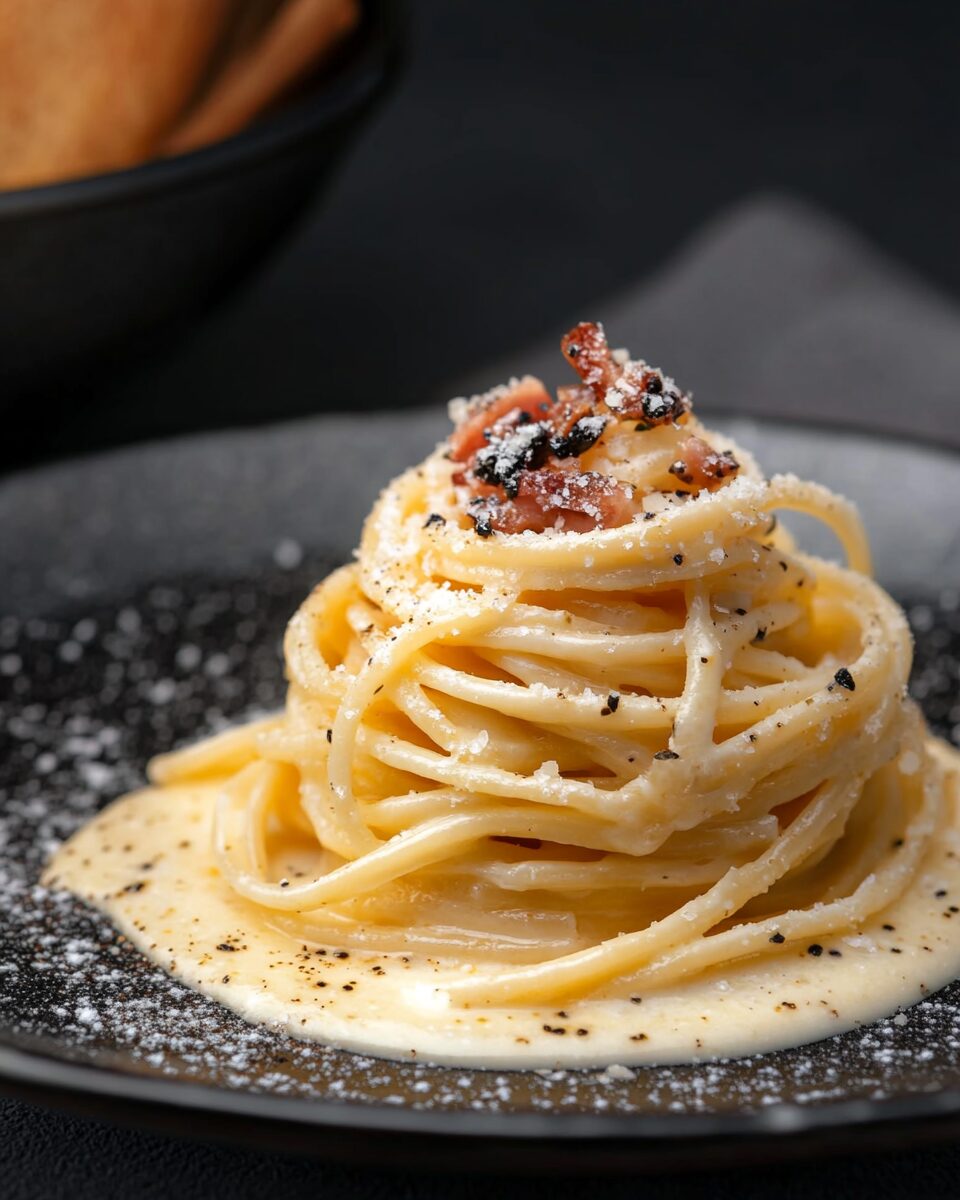Pasta alla Gricia is a delightful Roman classic that showcases the simplicity and richness of Italian cuisine. The dish combines crispy guanciale with a creamy pecorino romano sauce, coating each strand of pasta in an indulgent layer of flavor. A perfect balance of savory, cheesy, and peppery notes makes this dish a favorite among pasta lovers. Whether you’re looking to recreate a taste of Rome at home or simply searching for a comforting, elegant dinner, Pasta alla Gricia is a must-try. Its minimalist ingredients come together to create a dish that is rich yet beautifully simple, making it a standout in the realm of traditional Italian cooking.
Full recipe:
Ingredients:
- 11 oz spaghetti or tonnarelli
- 6 oz guanciale (or pancetta), cut into 1/2-inch strips
- 6 oz semi-aged pecorino romano cheese, finely grated
- 1 tbsp black pepper, freshly ground (medium coarse)
- 1/2 cup white wine
- Salt, to taste
Directions:
- Toast the Pepper: In a dry pan over low heat, briefly toast the black pepper until fragrant (about 1 minute). Set aside.
- Fry the Guanciale: Add the guanciale to a dry pan over medium-low heat. Fry until the fat becomes translucent, then increase the heat to crisp the pieces. Set aside.
- Cook the Pasta: Boil the pasta in salted water until it’s about 3/4 cooked to ‘al dente’ as per the package instructions.
- De-Glaze the Pan: Return the guanciale pan to heat and de-glaze with white wine, scraping the bits from the bottom of the pan.
- Combine Pasta and Guanciale: Drain the pasta and add it to the pan with the guanciale. Pour in a few ladles of pasta water to finish cooking the pasta and create a light sauce.
- Make the Cheese Sauce: Mix the grated pecorino with a ladle of hot pasta water to form a smooth paste.
- Finish the Dish: Remove the pan from heat, add the pecorino mixture, and toss to create a creamy coating over the pasta. Sprinkle toasted pepper and adjust salt if needed. Serve hot.
Prep Time: 15 minutes | Cooking Time: 10 minutes | Total Time: 25 minutes
Kcal: 450 kcal per serving | Servings: 4
Pasta alla Gricia: A Classic Roman Delight Worth Exploring
Pasta alla Gricia is one of the foundational dishes of Roman cuisine, often considered the “mother” of more famous pasta recipes like Carbonara and Amatriciana. This simple yet satisfying dish encapsulates the essence of Roman cooking: taking a few high-quality ingredients and turning them into something extraordinary. It’s an ideal choice for anyone who wants to experience the authentic flavors of Italy right at home, without needing to spend hours in the kitchen.
The History Behind Pasta alla Gricia
Originating in the Lazio region of Italy, specifically in Rome, Pasta alla Gricia dates back to a time before tomatoes were introduced to Italian cooking. It’s often referred to as a “white Amatriciana” because it shares many ingredients with Amatriciana but omits the tomato sauce, which became popular later in Italian history. This makes it a true testament to the traditional flavors of Rome—cheese, pork, and pasta.
The name “Gricia” is believed to come from the village of Grisciano, which is located near Amatrice, the birthplace of Amatriciana. Another theory suggests that it comes from the word “gricio,” a term that Romans used to describe food merchants who sold basic ingredients like pasta, cheese, and cured pork in the city’s markets. These ingredients are at the heart of Pasta alla Gricia.
What Makes Pasta alla Gricia Stand Out
- Simple Ingredients, Complex Flavors: What sets Pasta alla Gricia apart is its reliance on just four primary ingredients—spaghetti or rigatoni, guanciale (cured pork cheek), pecorino romano cheese, and black pepper. The absence of heavy sauces allows each element to shine, providing a harmony of textures and flavors that is both rich and satisfying.
- The Role of Guanciale: Guanciale is a key component that lends a distinctive depth of flavor to the dish. Made from the pig’s jowl or cheek, it has a higher fat content than pancetta, which allows it to render beautifully as it cooks. The fat from the guanciale coats the pasta, creating a silky, almost buttery texture that is elevated further by the sharpness of pecorino romano. Guanciale’s salty, slightly sweet flavor infuses the entire dish, making it a true star of Roman pasta.
- Creaminess Without Cream: One of the defining characteristics of Pasta alla Gricia is its creamy consistency, achieved without using cream. Instead, the creaminess comes from the way the grated pecorino romano melts into the hot pasta water, forming a velvety sauce. This technique, known as mantecatura, is what gives Pasta alla Gricia its luxurious texture. The result is a pasta dish that feels indulgent but is actually quite light.
- Perfect for Quick Meals: With a prep time of about 15 minutes and a cooking time of just 10 minutes, Pasta alla Gricia is perfect for busy weeknights when you want a delicious meal without the fuss. It’s easy enough for beginner cooks to master but impressive enough to serve to guests. The key lies in using the right technique and ingredients—freshly ground black pepper, high-quality pecorino romano, and authentic guanciale if you can find it.
Health Benefits of Pasta alla Gricia
While Pasta alla Gricia might not be the first dish that comes to mind when you think of health food, it does have some noteworthy benefits:
- Rich in Protein: The guanciale provides a good amount of protein, which is essential for muscle repair and overall health. While it is a fatty cut, the richness allows for smaller portions that are packed with flavor, making it easier to control your intake.
- A Source of Calcium: Pecorino romano, made from sheep’s milk, is a rich source of calcium and other minerals that are vital for bone health. It also adds a significant amount of flavor with a small quantity, allowing you to use less cheese without sacrificing taste.
- Good Fats: The guanciale provides monounsaturated fats, similar to those found in olive oil, which can be beneficial for heart health when consumed in moderation. These fats are known to help reduce bad cholesterol levels, making them a better choice than some other types of animal fat.
- Complex Carbohydrates: The pasta provides a steady source of complex carbohydrates, which can fuel your body and keep you feeling full longer. Choosing high-quality pasta made from durum wheat also ensures that you get a good amount of fiber, especially if you opt for whole grain varieties.
Why Pasta alla Gricia Is the Best
- An Authentic Roman Experience: When you make Pasta alla Gricia, you’re not just cooking a dish—you’re connecting with centuries of Italian culinary tradition. The recipe has remained largely unchanged for generations, a testament to its enduring appeal. It’s a dish that Roman chefs pride themselves on mastering, and its simplicity allows the ingredients to shine.
- Versatile and Adaptable: While Pasta alla Gricia is perfect in its classic form, it’s also highly adaptable. Some cooks like to add a splash of white wine during the deglazing process to bring a little acidity and complexity to the dish. Others might experiment with adding different types of pasta, such as rigatoni or tonnarelli, to change up the texture. You can even substitute pancetta for guanciale if it’s easier to find, though the result will have a slightly different flavor profile.
- A Celebration of Quality Ingredients: This dish is a great reminder of the importance of quality ingredients in Italian cooking. The beauty of Pasta alla Gricia lies in how it transforms just a few elements into something deeply satisfying. Using freshly grated pecorino romano and medium-coarse ground black pepper makes all the difference, allowing the flavors to meld together perfectly.
- A Dish for All Occasions: Whether you’re hosting a dinner party or simply enjoying a quiet night at home, Pasta alla Gricia fits the bill. It’s comfort food that feels special, a dish that you can turn to again and again. The balance of savory guanciale, sharp cheese, and peppery kick is enough to satisfy any pasta lover.
Tips for Perfecting Pasta alla Gricia
- Control the Heat: When frying the guanciale, start with a lower heat to render the fat and then increase it to achieve a crispy exterior. This method ensures that the guanciale pieces have a melt-in-your-mouth texture while adding a crunchy element to the final dish.
- Don’t Overcook the Pasta: Remember to undercook the pasta slightly before adding it to the pan with the guanciale. The pasta will finish cooking in the skillet, absorbing the rendered fat and creating a beautiful, cohesive sauce.
- Master the Cheese Sauce: To avoid clumps in your cheese sauce, always add the pecorino cheese paste to the pasta off the heat. Mix vigorously with tongs to ensure an even coating and a smooth, creamy finish.
Conclusion
Pasta alla Gricia is more than just a recipe; it’s a culinary tradition that captures the spirit of Rome in every bite. Its simplicity allows it to be accessible to cooks of all levels, yet its depth of flavor makes it a standout among Italian pasta dishes. By focusing on the quality of ingredients and mastering a few key techniques, you can recreate this iconic dish in your own kitchen and experience a taste of authentic Roman cooking. So, whether you’re a pasta enthusiast or a newcomer to Italian cuisine, Pasta alla Gricia is a must-try that promises to delight your taste buds with every forkful.






